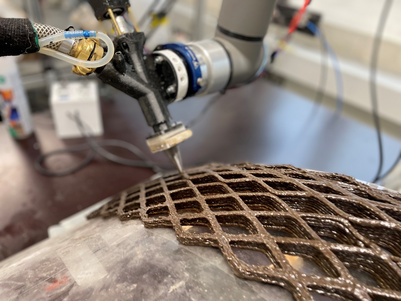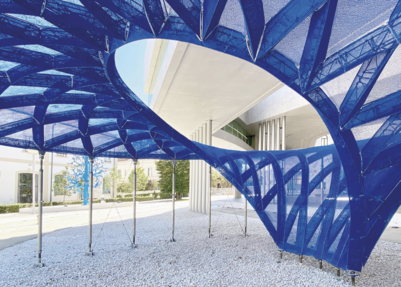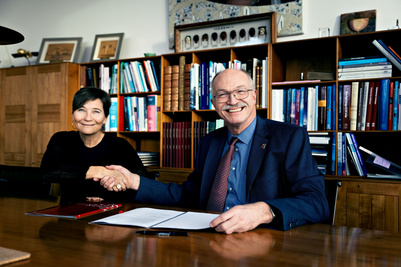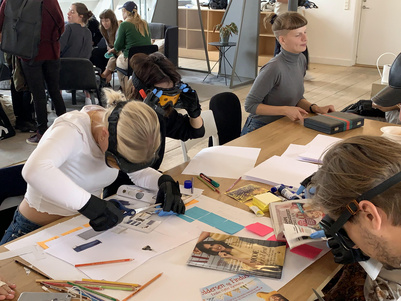Master’s Graduation Project 2015: Co-design for the Future of the UN and Kosovo
Can activities such as going for a walk, workshops and ‘discussion cinemas’ help to involve young people in the development of once-war-torn Kosovo? The United Nations, the world’s largest democratic organisation, believed that they could. Therefore, they invited students from the Centre for Co-design to come up with a proposal for how to give young Kosovars a voice in the public debate. In their joint graduation project, Maria Søbroe and Rasmus Michaëlis used the co-creation design method to increase levels of commitment among young Kosovars, and to involve them in the development of a region that is still scarred by its turbulent past.
What is your Master’s graduation project about?
More than a decade after the end of the civil war in Kosovo, young Kosovars are still facing a number of challenges when it comes to actively participating in the development of their country. According to the United Nations, the desire of these young Kosovars to participate remains unaddressed by institutions. As a result, young people remain outside the public debate.
Working together with students from the University of Pristina and staff from the different UN units operating in Kosovo, we experimented with new ways of meeting, discussing and sharing concerns. We did this by means of a series of collective activities, which included going on exploratory walks together and holding workshops. To help us meet our objective of developing a language that young Kosovans could use to become more committed, we used the medium of film in a very special way. These films were screened in a ‘dialogue cinema’, where more than 100 young people took part in a discussion on the topic of the actual commitment of young people in Kosovo.
One result from the project was a catalogue of the different stories and experiences told by us, by the UN and by students from the University of Pristina. A second result came in the form of three specific recommendations to the UN, detailing how the organisation could benefit from continuing to use co-design methods in its work with local young people as part of a major youth programme in Kosovo.
What have you gained from working together with an external partner on a specific real-world issue?
Essentially, working on a real issue and working with external partners helped make the project relevant. We had to take into others into consideration, rather than just focussing on our own desks and on ourselves. And we had to consider the interests of all the different stakeholders in the project and also negotiate in situations were there is disagreement.
Our co-operation with the UN and with the young local Kosovans opened the door to a whole new area: co-design in development work. For UN projects to be sustainable, it is important for citizens to be involved in development work. We found out that our qualitative and participatory approach was both a relevant and a valuable addition to the traditional methods used by the UN.
What is most fun and what things are hardest when working on design in the way that you do?
The hardest part is also the part that is most fun. Because our way of working is exploratory, we are always thrust into unfamiliar situations, the outcomes of which we do not often know. This level of uncertainty is certainly a challenge, but at the same time it is extremely exciting. We meet a lot of new people from other cultures, and we get the chance to discover new towns and cities.
When the time came for us to develop the ‘dialogue cinema’ (which was a central element of the whole project), we found ourselves in the middle of the small Kosovan town of Gjilan. We were there together with a group of local students, whom we had met twice before, and who were entrusted with transforming the local sports hall into a cinema in the space of just a few hours. In a situation like that, you have to draw on your sense of professionalism in order to stay on top of things and keep up the pace.
But, as travelling designers, we have also learned that reaching a goal requires more than mere reliance on professionalism. You are also very much involved in the partnerships and collaborations on a personal level. And it can be a challenge when the two aspects merge.
What do you consider to be your greatest strengths as a KADK design graduates?
We are able to work in many different contexts and across different disciplines. We can translate abstract ideas into something tangible by creating visual, detailed concepts that can create new, shared understanding across all professional fields. We can use that understanding to develop alternative solutions for the everyday life of tomorrow.
We explore the complex issues of design research, and come up with ideas and solutions in collaboration with the stakeholders involved. This makes both the process and the products more valid, valuable and sustainable.
Where do you see yourself in 5 years?
The focus of our professional development is different for each of us, but we would both like to continue studying and developing design work rooted in people’s everyday lives.
Rasmus sees himself as being a researcher in the design field, still with co-design as its focal point. Maria would like to work as a cross-disciplinary consultant, possibly self-employed or affiliated with an organisation or company.









